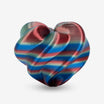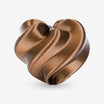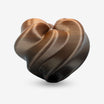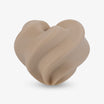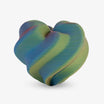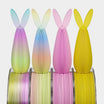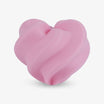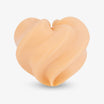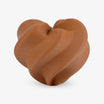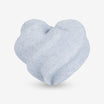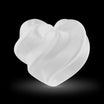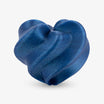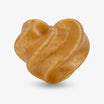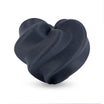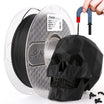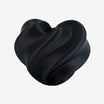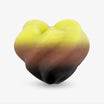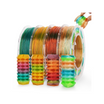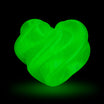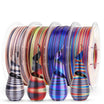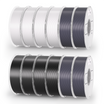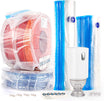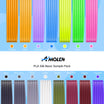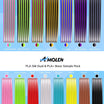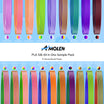Matte filament, also known as matte finish filament, is a type of 3D printing material that produces a distinct non-reflective finish. This filament is becoming increasingly popular due to its unique texture and appearance, which is different from the traditional glossy sheen of most 3D prints.

Properties of Matte Filament
Matte filament is primarily made of the same base materials as traditional 3D printing filaments such as PLA, ABS, or PETG. The key difference lies in the specialized additives incorporated into the filament during the manufacturing process. These additives work to scatter light, effectively reducing the shininess of the finished product and resulting in a uniformly matte texture. Matte filament is available in a wide variety of colors, including trending multicolor and pastel variations, allowing for a diverse palette that can be used to create a range of finishes, from a subtle matte effect to a completely non-reflective surface.
One of the significant advantages of matte filament is its exceptional ability to minimize the visibility of imperfections or layer lines that are typically more prominent on glossy prints. The non-reflective surface also makes it an ideal choice for creating objects that require low reflectivity, such as professional photography props or detailed film sets. Beyond aesthetics, some matte formulations may offer a slightly more rigid feel compared to their standard counterparts, contributing to a premium tactile experience.
Optimal Settings for Printing with Matte Filament
While matte filament is generally user-friendly, fine-tuning your 3D printer settings can significantly impact the quality of its unique finish and ensure successful prints.
- Nozzle Size: For optimal results and to prevent potential clogging from the light-scattering additives, it's often recommended to use a standard 0.4mm nozzle or even a larger 0.6mm nozzle, especially if you encounter extrusion issues.
- Print Temperature: While typically within standard PLA/PETG/ABS ranges, observe how temperature affects the matte finish. Printing too hot might introduce a slight sheen, counteracting the desired matte effect. A temperature tower print can help pinpoint the ideal temperature.
- Print Speed: Slightly slower print speeds can help ensure even extrusion and proper cooling, contributing to a consistent matte surface. This allows the material to cool and solidify with its intended texture.
- Retraction Settings: Like all filaments, proper retraction (distance and speed) is crucial to minimize stringing and oozing. Fine-tune these settings to prevent material from lingering in the hot end, which could lead to clogs or shiny spots.
- Cooling: Adequate part cooling is important to maintain the matte finish and prevent glossiness. However, excessive cooling might lead to poor layer adhesion.
Troubleshooting Common Matte Filament Issues
Even with optimized settings, sometimes issues arise. Here’s how to address common challenges specific to matte filament:
- Layer Lines Still Visible: While matte filament helps hide lines, perfect print calibration (Z-offset, extrusion) is still essential. Ensure your slicer settings match the filament's diameter precisely.
- Nozzle Clogging: If clogging occurs, check your nozzle size, print temperature, and retraction settings. Regular cold pulls can help prevent build-up. Ensure your filament is dry, as moisture can exacerbate clogging.
- Brittle Prints: If your matte prints feel overly brittle, it might indicate insufficient print temperature, excessive cooling, or moisture absorption by the filament. Adjust settings or dry your filament.
Applications of Matte Filament
Matte filament is used for a variety of applications in the 3D printing industry, where its unique visual and tactile properties are highly valued. Some of the most common applications include:
- Photography props: Matte filament is often used to create props for photography shoots or film sets. Its non-reflective finish is ideal for crafting realistic props that do not produce unwanted glare or reflections under studio lighting.
- Architectural models: Matte filament is also a popular choice for creating architectural models that require a professional, non-reflective finish. This is especially important for models that will be showcased, photographed, or filmed, where a realistic scale appearance is crucial.
- Light fixtures: Its light-absorbing properties make matte filament excellent for creating decorative light fixtures, lampshades, or diffusers that require a non-reflective surface, producing a soft, diffused light effect.
- Artistic creations: Matte filament can be used to create a range of artistic creations, from sculptures and busts to intricate 3D printed paintings. The non-reflective finish adds a unique, premium texture and depth to the final product, resulting in a one-of-a-kind piece of art.

Is Matte Filament Right for Your Projects?
Matte filament is a truly unique 3D printing material that offers a sophisticated, non-reflective finish to prints. The use of specialized additives in the manufacturing process results in a textured surface that expertly hides minor imperfections and layer lines, elevating the overall aesthetic of your 3D models. Matte filament is suitable for a wide range of applications, from professional photography props and detailed architectural models to stunning artistic creations.

